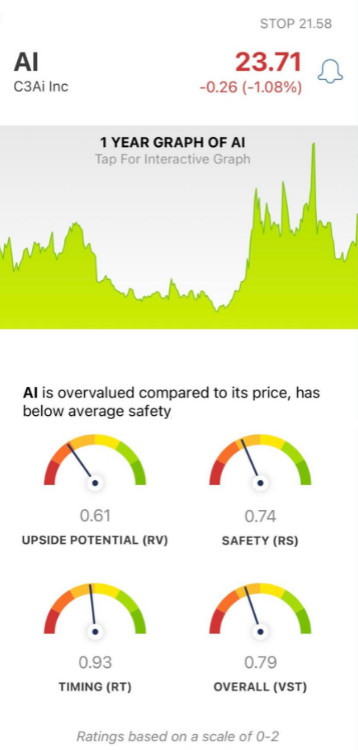20 Great Pieces Of Advice For Deciding On AI Stock Predicting Websites
20 Great Pieces Of Advice For Deciding On AI Stock Predicting Websites
Blog Article
Top 10 Things To Consider When Considering Ai And Machine Learning Models On Ai Trading Platforms For Stocks
To guarantee accuracy, reliability, and actionable insights, it is crucial to examine the AI and machine-learning (ML), models used by prediction and trading platforms. Models that are poorly designed or overhyped could lead to inaccurate predictions and financial loss. Here are ten of the most effective tips to help you evaluate the AI/ML model of these platforms.
1. Understand the Model's Purpose and Method of Approach
The goal must be determined. Make sure the model has been developed to allow for long-term investments or trading in the short-term.
Algorithm transparency: See if the platform provides the type of algorithms used (e.g., regression, neural networks, decision trees and reinforcement learning).
Customization. Examine whether the model's parameters are adjusted to fit your specific trading strategy.
2. Evaluation of Model Performance Metrics
Accuracy: Verify the model's accuracy in forecasting the future. But, don't just rely on this metric as it may be inaccurate when applied to financial markets.
Recall and precision: Determine how well the model can discern true positives, e.g. correctly predicted price changes.
Risk-adjusted returns: Determine the likelihood that the model's predictions will result in profitable trades after accounting for risk (e.g., Sharpe ratio, Sortino ratio).
3. Check the model by Backtesting it
Performance history The model is tested using historical data in order to determine its performance under prior market conditions.
Tests on data not intended for training To avoid overfitting, try testing the model using data that was never previously used.
Scenario analyses: Compare the model's performance under different markets (e.g. bull markets, bears markets high volatility).
4. Check for Overfitting
Overfitting signs: Look out for models that do exceptionally well with training data, but struggle with data that isn't seen.
Regularization methods: Check whether the platform is not overfit using regularization techniques such as L1/L2 and dropout.
Cross-validation (cross-validation): Make sure the platform is using cross-validation to assess the model's generalizability.
5. Examine Feature Engineering
Relevant features: Verify that the model has relevant attributes (e.g. price, volume and technical indicators).
Feature selection: Ensure the system chooses characteristics that have statistical significance and eliminate irrelevant or redundant data.
Dynamic features updates: Check whether the model adjusts in time to new features or changing market conditions.
6. Evaluate Model Explainability
Interpretability: Ensure the model provides clear explanations for its predictions (e.g. SHAP values, the importance of features).
Black-box models: Be cautious of platforms that use excessively complicated models (e.g., deep neural networks) with no explainability tools.
The platform should provide user-friendly information: Make sure the platform offers actionable insights which are presented in a way that traders can comprehend.
7. Examine Model Adaptability
Changes in the market: Check if the model can adapt to changing market conditions (e.g. new regulations, economic shifts, or black swan occasions).
Verify that your system is updating its model on a regular basis by adding new data. This will improve the performance.
Feedback loops. Be sure to incorporate the feedback of users or actual results into the model in order to improve it.
8. Examine for Bias and fairness
Data bias: Ensure that the training data is representative of the market and free from biases (e.g. excessive representation of specific segments or timeframes).
Model bias: Determine whether the platform monitors and corrects biases within the predictions made by the model.
Fairness - Make sure that the model you choose to use isn't biased towards or against particular sector or stocks.
9. Calculate Computational Efficient
Speed: Check if the model can generate predictions in real time or with minimal latency, especially in high-frequency trading.
Scalability: Determine if the platform can handle large datasets and multiple users without performance degradation.
Resource usage: Check if the model has been optimized to use computational resources effectively (e.g. use of GPU/TPU).
Review Transparency and Accountability
Model documentation. Make sure you have a thorough documentation of the model's architecture.
Third-party validation: Find out whether the model has been independently validated or audited by an outside party.
Error handling: Check for yourself if your software incorporates mechanisms for detecting or rectifying model errors.
Bonus Tips
Reviews of users and Case studies: Review user feedback, and case studies to assess the performance in real-world conditions.
Trial time: You may utilize a demo, trial or free trial to test the model's predictions and its usability.
Customer support: Ensure the platform provides robust support for technical or model issues.
The following tips can help you assess the AI models and ML models that are available on platforms that predict stocks. You'll be able to determine whether they are honest and reliable. They should also align with your trading objectives. Follow the best ai for stock trading hints for more recommendations including investing ai, ai investing app, best stocks to invest in, ai trade, best ai copyright trading bot, ai for investing, ai for stock trading, stock market ai, chart analysis ai, ai trading platform and more.
Top 10 Tips On Assessing The Educational Resources Of Ai Stock Analysing Trading Platforms And Forecasting Their Future
Assessing the educational resources provided by AI-powered stock prediction and trading platforms is essential for those who use them to learn how to use the platform, understand the results and make informed trading choices. Here are the top 10 methods to evaluate the effectiveness and the quality of these educational resources.
1. Complete Tutorials and Guides
Tips: Check if the platform has tutorials that walk you through every step, or guides for advanced and novice users.
What's the reason? Clear directions are helpful for users to use the platform.
2. Webinars and Video Demos
Look out for video demonstrations or webinars, or live sessions.
Why Visual and Interactive content can help you grasp difficult concepts.
3. Glossary
Tips - Make sure the platform has an explanation of the glossary and/or definitions of the most important AI and finance terminology.
The reason: This can help users, particularly beginners, understand the terminology used in the platform.
4. Case Studies and Real-World Examples
Tip: Determine if the platform offers examples of case studies, or actual examples that demonstrate how AI models are applied.
The reason: Examples of the platform's functionality and applications are made available to help users understand the platform's features and capabilities.
5. Interactive Learning Tools
Tip - Look for interactive features such as games and sandboxes.
What's the reason? Interactive tools allow users to try and improve their skills without risking money.
6. Updated content
Consider whether educational materials are frequently updated in order to reflect the latest trends in the market, as well as new features, or changes to the regulations.
The reason: Incorrect data could cause misinterpretations or improper application of the platform.
7. Community Forums and Support
Tips: Find active support groups or community forums where members can share their knowledge and ask questions.
The reason Support from peers and expert guidance can improve learning and problem-solving.
8. Accreditation and Certification Programs
Find out whether there are any certification programs or training courses that are accredited that are offered by the platform.
The reason is that formal recognition of learners' learning can encourage them to study more.
9. Accessibility and User-Friendliness
Tips: Evaluate how the accessibility and ease of use of educational resources are.
Reason: The ease of access allows users to study according to their own pace.
10. Feedback Mechanisms for Educational Materials
Tip: Check if the platform allows users to give feedback about the educational material.
What is the reason: Feedback from users helps improve the quality and relevance of the resources.
Different learning formats are offered.
To accommodate different tastes, ensure the platform provides different learning formats.
When you take a close look at these elements and carefully, you will be able to determine whether the AI technology for stock trading and forecasting provide you with robust educational materials which will allow you to maximize their potential and make educated decisions. View the most popular stock predictor for blog info including chart analysis ai, incite, ai stocks to invest in, best ai stocks to buy, best free copyright trading bot, best ai stocks, best free copyright trading bot, invest in ai stocks, ai trading software, ai stock picker and more.